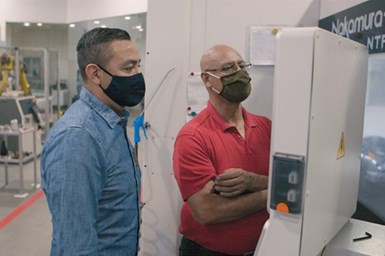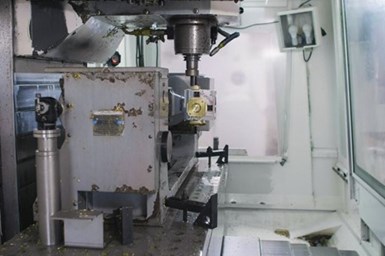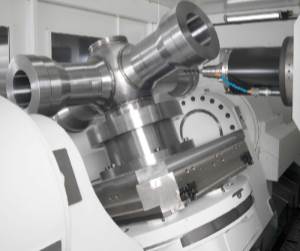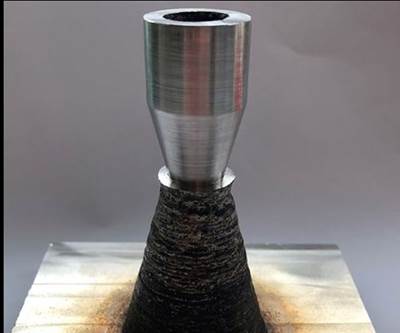Esprit Software Keeps Wet Design Agile
The Esprit CAM system has enabled artistic fountain creator Wet Design to increase efficiency and spend its time creating instead of troubleshooting code.
Share








ECi Software Solutions, Inc.
Featured Content
View More

Autodesk, Inc.
Featured Content
View More
Wet Design streamlines production by performing all its processes in house. Esprit helps the company stay on track for tight deadlines across its many machines.
If you’ve ever scrambled for a prime spot to watch the Fountains of Bellagio in Las Vegas, stopped to rest at the fountains at Salt Lake City’s City Creek Center, enjoyed the Cauldron of the 2002 Winter Olympics or even the fountain of the 2014 Winter Olympics, you’ve enjoyed the work of Wet Design. The southern California company was founded in 1983 by former Disney Imagineers. It creates artistic water features that regularly push engineering technology to its limits with each installation including a vast underground network of complex parts.
Wet’s design, engineering and manufacturing teams require a varied array of machines to keep their work on the cutting edge. Its shop floor features a Nakamura NTRX300 mill-turn, 10 Haas lathes, 10 Haas mills, two Haas horizontal mills, two Mori Seiki NL-2500s, a Makino wire EDM and a Makino high-speed tooling mill, among others.
In order to bring its creations to life, Wet Design manufactures an array of parts as diverse as its machines, including valves, robotic nozzles, electronic controls, underwater lights, molds and tooling. These parts are primarily made from stainless steel.
For the last 12 years, Wet has relied on Esprit CAM software from DP Technology. Wet first turned to the software to support its programming needs for mill-turn machines.
“We program our parts with Esprit and we can make them with minimal editing because the posts that Esprit provides are tailored to each specific machine,” says Oscar Ramirez, senior CNC programmer at Wet. “Before Esprit, we had to do a lot of editing and manual programming to get the machine to make the parts we needed. Esprit was the solution because I wanted our focus to be on the machining aspect and more effectively planning our schedule in advance rather than spending a lot of time trying to get a project to come out right.”
Staying Agile in House
Wet keeps its processes in house, forcing it to simplify designs to reduce manufacturing costs. When it can’t further simplify designs, it relies on four- or five-axis machines. What’s more, keeping work in house means Wet needs to remain flexible.
“Our project priorities can turn on a dime,” Ramirez says. “For example, we make parts for our service department, and those take priority. We have to be very agile.”
Part of this flexibility comes from the machine swap feature. The company uses the machine swap feature to change a setup in multiple machines, even moving setups from one machine to another. The software can automatically translate the tool path to the new machine without having to reprogram the part itself.
Wet used this feature when it needed to increase production of a complex spider part. The part features three windows and looks like a 6-inch steering wheel with a small square window in the center. Wet used its Nakamura mill-turn with a simultaneous five-axis tool path to produce the window features, which have chamfers with variable angles. At the beginning of the project, Wet could meet the demand for the parts with just one machine. However, the assembly rate improved when the assembly shop added a second shift, so the company needed to add a second machine to increase its daily spider production.
“We already had the tool path, so we swapped the machine setup in the software to a Haas machine with a trunnion and made a couple of changes to the process. We then had two different machines running the same part with the same five-axis tool path,” Ramirez says.

Programming parts in Esprit has allowed Wet to streamline multi-machine processes into done-in-one operations.
Done in One
Ramirez says Esprit software has helped Wet save time in many ways. In one case, the company was using a CNC mill and a CNC lathe to produce a 12-inch “skillet” part made of 303SS barstock. The production process required two long setups, two machines and two operators to run. To improve efficiency, the company decided to make a new program in Esprit to combine the operations and run them on the Nakamura mill-turn in one cycle. Ramirez estimates that this move saved about three hours of setup time while freeing up an operator.
Ramirez says that if his team ever encounters an obstacle, he can count on Esprit's customer service, which usually responds within a day to his team’s questions.
“We’re a project-based company, and sometimes the timeline to develop, produce and deliver is very short. While we always have a couple of very big projects on the horizon, we expect to get many smaller projects as well,” Ramirez says. “As a result of the short turnaround time, we have to constantly keep improving our methods and techniques so we can accommodate these projects, support our existing projects and keep growing. Esprit plays a vital role because we get great tool paths and the code is correct.”
Related Content
Cutting Part Programming Times Through AI
CAM Assist cuts repetition from part programming — early users say it cuts tribal knowledge and could be a useful tool for training new programmers.
Read MoreHow this Job Shop Grew Capacity Without Expanding Footprint
This shop relies on digital solutions to grow their manufacturing business. With this approach, W.A. Pfeiffer has achieved seamless end-to-end connectivity, shorter lead times and increased throughput.
Read MoreHow to Mitigate Chatter to Boost Machining Rates
There are usually better solutions to chatter than just reducing the feed rate. Through vibration analysis, the chatter problem can be solved, enabling much higher metal removal rates, better quality and longer tool life.
Read MoreGenerating a Digital Twin in the CNC
New control technology captures critical data about a machining process and uses it to create a 3D graphical representation of the finished workpiece. This new type of digital twin helps relate machining results to machine performance, leading to better decisions on the shop floor.
Read MoreRead Next
What Can 5-Axis Machining Do for Your Shop?
If you haven’t looked at 5-axis machining lately, a lot has changed. Advancements in 5-axis machines, controls and software have made this technology so affordable and easy to use that it can benefit almost any shop.
Read MoreSimulation Gets Real
Capability to generate something close to a true digital twin can significantly improve confidence in CAM program prove-outs.
Read MoreCombining Additive and Subtractive Processes for Hybrid Machining
At this point, we are still learning how to combine the two to optimize hybrid manufacturing.
Read More















































